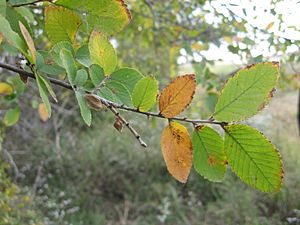Ulmus crassifolia facts for kids
Quick facts for kids Ulmus crassifolia |
|
|---|---|
 |
|
| Conservation status | |
| Scientific classification | |
| Genus: |
Ulmus
|
| Species: |
crassifolia
|
 |
|
| Natural range (Florida population excluded) | |
| Synonyms | |
|
|
The Ulmus crassifolia, also known as the Texas cedar elm or just cedar elm, is a deciduous tree. This means it loses its leaves every year. It grows naturally in south-central North America.
You can find it mostly in southern and eastern Texas, southern Oklahoma, Arkansas, and Louisiana. Smaller groups grow in western Mississippi, southwest Tennessee, and north-central Florida. It also lives in northeastern Mexico. The cedar elm is the most common elm tree in Texas. It often grows well in flat valley areas, which people call 'Cedar Elm Flats'. Its common name, 'cedar elm', comes from how it often grows near juniper trees, which are locally called "cedars."
Contents
What Does a Cedar Elm Look Like?
The cedar elm is a medium to large tree. It can grow very tall, reaching about 24 to 27 meters (80 to 90 feet) high. It has a rounded top, which is called its crown.
Its leaves are small, usually 2.5 to 5 centimeters (1 to 2 inches) long. They are about 1.3 to 2 centimeters (0.5 to 0.8 inches) wide. The leaves have a slanted base. This tree keeps its leaves late into the year, often until early winter.
The cedar elm's perfect flowers are pollinated by the wind. They appear in late summer or early fall. These flowers are small and not very noticeable. They have a reddish-purple color. The fruit is a small, winged seed called a samara. It is about 8 to 10 millimeters (0.3 to 0.4 inches) long. The fruit ripens quickly after the flowers bloom in late fall.
Pests and Diseases
Cedar elms can get certain diseases and pests. One serious problem is Dutch elm disease (DED). However, cedar elms are not as easily affected as some other elm trees, like the American elm. They can also be moderately damaged by the elm leaf beetle. This beetle is known as Xanthogaleruca luteola.
The tree can also suffer from a disease called vascular wilt. Its symptoms are sometimes mistaken for Dutch elm disease.
Mistletoe
Cedar elms are very likely to get mistletoe. Mistletoe is a type of plant that acts like a parasite. It attaches its roots into the tree's system, stealing important nutrients and water. If not removed, mistletoe can seriously harm large parts of the tree. It can even kill the tree.
Mistletoe causes branches to become club-shaped and die at the ends. These "club" branches can create openings for other pests, like elm beetles and carpenter ants. There are no known treatments that can kill mistletoe without also harming the tree. Removing the mistletoe by hand is the best way to control it, though it does not guarantee the mistletoe will not return.
Where Cedar Elms Grow
U. crassifolia is very rare in places like Europe and Australasia. Some trees were sent from a nursery in Berlin starting in the late 1800s. Experts like Henry (1913) and Bean (1988) noted that it does not grow well in northern Europe. In those areas, its small branches often die back.
Three trees were sent to the Royal Botanic Garden Edinburgh in 1902. They were labeled as U. crassifolia. These trees might still be in Edinburgh today. The garden used to plant trees around the city.
Notable Trees
The largest known cedar elm in the United States is called the US National Champion. In 2001, it was measured at 37 meters (about 121 feet) high. This impressive tree grows in the Meeman-Shelby Forest State Park in Tennessee.
Images for kids
-
Migrating monarch butterflies on a cedar elm in central Texas
See also
 In Spanish: Ulmus crassifolia para niños
In Spanish: Ulmus crassifolia para niños





